In addition to simple precautionary measures that shouldn’t be neglected in the process of fishing, namely: one shouldn’t catch fish in a thunderstorm or under a stormy sky, one should avoid fishing during a severe storm at sea, one should choose shoes thoughtfully, if you are going to fish on the rocky sea shores or stony river banks, one should always have a first aid kit, it makes sense to be aware and remember the troubles that can be caused by the inhabitants of the waters of the Adriatic Sea or freshwater bodies of the region during fishing, as well as after it.
Information about dangerous representatives of the Mediterranean Sea and its coasts is scattered over the Internet and can be partly found in various articles. It is often presented with errors and inaccuracies. Moreover, it will take some effort to find it. However, adriaticnature decided to put all the information together, being sure that such a background material will be useful for fishermen and tourists who got a chance to spend some time on the beautiful shores of the Adriatic.
The encounter with the fish of the Trachinoidei suborder may cause the most serious troubles during fishing on the sea. Weevers don’t shoot out flames from their mouths, however, they have other dangerous weapons.
4 species of the Trachinidae family inhabit the Adriatic Sea. The most common species are the greater weever (Trachinus draco) and the lesser weever (Echiichthys vipera). All representatives of this family are united by their love of the sandy bottom, near which the settle down. They are very difficult to detect, because the weevers spend most of their time buried in the sand with only the head sticking out. They quickly jump out of their sand hide to grab the fish passing by.
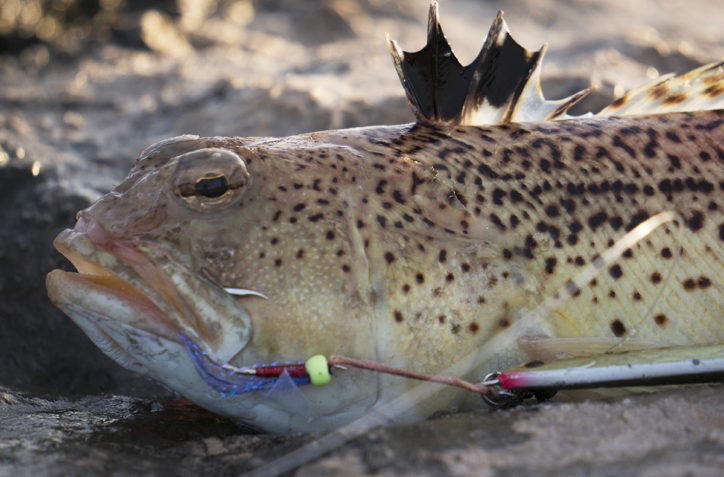
(Greater weever. Photo by © adriaticnature)
These small beautiful fish often choose to inhabit the same places, which are chosen by fans of beach vacations. That’s why, they pose danger not only for fishermen, but also for those who swim and bathe on the sandbanks. The weever is almost impossible to spot at the bottom and one can easily step on it, while going into the water. One can also touch it accidentally with another part of the body, while floating in coastal waves.
The spines of the first dorsal fin of the weevers and the sharp spine on the operculum have venom glands. When you are stung, you get an unpleasant sensation at the point where the spine is stuck, and 2-3 minutes later you have severe pain, which is much more noticeable than in case of a wasp or bee sting.

(Greater weever. Photo by © adriaticnature)
The venom contains proteins that cause depolarization of the cellular membrane and hemolysis. It acts as a neurotoxin and as a hemotoxin. The victim develops itching, swelling, fever, redness, numbness, tingling in the place of stinging. Nausea, vomiting, joint pains, headaches, spasms in the abdomen, dizziness, increased urination and tremor of the limbs can be general symptoms. In rare cases, the following symptoms of severe poisoning are observed: breathlessness, cardiac arrhythmia, arterial blood pressure reduction, cramps, unconsciousness, as well as local complications, including gangrene and extracellular degeneration.
The statistics of encounters of people bathing in the coastal waves and weevers reveals that unpleasant incidents occurred mainly during low tides and in August. This is not a reason for refusing to swim in this time period, but it should be kept in mind. Individual chances of bathers being stung by spines of these fish are very low.
Chances are much higher that the fisherman catches the weever and touches its spines either out of ignorance or because the fish was grabbed the wrong way. The weevers are active and voracious from dawn to dusk and they may attack a wide variety of lures and baits that occur close to them near the bottom. Therefore, catching the weever in the Adriatic is quite an ordinary event, and, of course, when fishing on the sea, one should always have accessories that enable to take the fish off a hook without touching it with hands.
The weevers are considered to be a delicacy and when large specimens are caught they are often taken to fishermen’s kitchens. It must be kept in mind that the spines of a dead weever are just as dangerous as the ones of a still alive fish. Therefore, if a decision of a sad fate for the fish has been made, you should carefully remove the first dorsal fin and spines from the operculum with scissors before cleaning and cooking it. The venom of the weever disintegrates at high temperatures, being heat labile.
(Greater weever. Video by © Alexandr Kurakin)
What should be done, if the unpleasant part of the acquaintance with this cute fish took place anyway? First of all, don’t panic. Get ready to suffer unpleasant painful sensations, which usually reach their peak in half an hour after the moment of stinging, they will soothe later.
If the fish spines stung you near the populated area, you should urgently move to the place, where it is possible to dip the stung limb into hot water. This will promote the destruction (denaturation) of the venom. Water should be as hot as you can stand it and, of course, the temperature shouldn’t be high enough to cause burns (usually about 45 degrees Celsius). Destruction of the venom at these temperatures is just one of the scientific theories. There are other scientific versions trying to explain the way the hot water brings relief to the victim.
The more time from the moment of stinging to the moment of dipping into the hot water has passed, the more time the stung part should be kept in the water. The process should take at least 20-30 minutes. When the severe pain begins to subside, the stung part should be checked for possible presence of pieces of spines in the wound, which should be carefully removed from the wound. Painkillers (aspirin, ibuprofen) will reduce swelling and pain. It would be nice to take antihistamine drugs. And increased fluid intake is obligatory. If the above mentioned measures were taken, and the condition keeps worsening, you should seek medical attention.
The pain subsides considerably in a few hours, even if there’s no opportunity to take any action. Full recovery can take a week or more. Scientists admit the fact that the fatal outcome after the sting of the weever may occur. However, documentary evidence of such cases hasn’t been recorded.
Another representative of the Trachinoidei suborder can cause trouble as well. Common stargazer (Uranoscopus scaber).
(Stargazer. Video by © Alexandr Kurakin)
This fish is more common at depths of more than 15 meters. It rarely reaches the shoals. Like the weevers, the common stargazer is hunting its victims, burying itself into the sand, from which only a part of the head sticks out. But unlike the weevers, it is not dangerous for the fans of beach vacations. However, fishermen should be very careful with the stargazer.
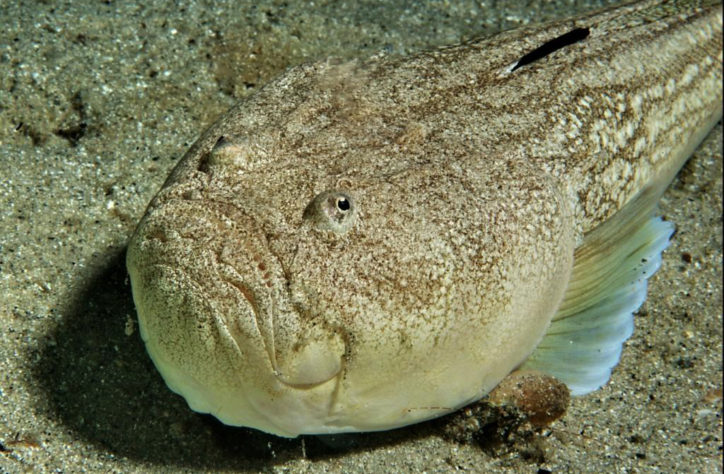
(Stargazer. Photo by © Protesilao. naturamediterraneo.com)
There are spines with venom glands on the operculum, on the first dorsal fin and above the pectoral fins of the stargazer. The consequences of its sting are manifested in the same way as the sting of the weever. However, it often follows the lighter form.
The symptoms are the same, the first aid is the same. Hot water, painkillers and antihistamines are required.
7 fish species represent the Scorpaenidae family in the Adriatic Sea, but the following three of them are more commonly found: red scorpionfish (Scorpaena scrofa), black scorpionfish (Scorpaena porcus) and small red scorpionfish (Scorpaena notata).
(Black scorpionfish. Video by © Alexandr Kurakin)
Scorpionfishes (Scorpaena) are twilight predators that don’t pose any danger to the people having rest on the shores of the Adriatic Sea. However, fishermen, who can easily catch scorpionfishes, should be aware of several unpleasant features of these beauties.
It’s quite difficult to mistake other inhabitants of the sea for scorpionfishes. One can immediately recognize them by the way they look, when they are caught. They seem to be “disheveled” and dissatisfied with what is happening. And this look is kept in mind forever. Although scorpionfishes make some people smirk, others feel affection toward them, these fish should be treated really carefully. Despite the range of sizes these fish can be – fishermen rarely catch small red scorpionfishes larger than 10 cm, and large-scaled scorpionfishes, which are more often caught from floating crafts, weigh more than two kilograms – venom spines of all these species are equally unpleasant.

(Black scorpionfish. Picture by © adriaticnature)
The spines are located in the dorsal, anal and pectoral fins. Symptoms after stinging are similar to the consequences of the stings of representatives of the Trachinoidei suborder, but usually it’s a little easier to live through the pain.
The venom is destroyed at high temperatures.
Due to the size of the fish, large-scaled scorpionfish can cause more troubles than stinging of small species.
First aid is the same: hot water, painkillers and antihistamines are required.

(Red scorpionfish. Picture by © adriaticnature)
Meeting a rare inhabitant of the southern part of the Adriatic Sea, the rabbit fish (Chimaera monstrosa), is extremely unlikely. The inhabitant of the sea depths is occasionally observed in winter at depths of 40-150 meters, feeling more comfortable at the depth of 300 meters.
The first dorsal fin is high and short, with a sufficiently long, venomous spine at its front edge. Stinging is very painful, but usually it doesn’t have serious health consequences.

(Rabbit fish. Photo by © sogning. wikipedia.org)
9 rays of the Myliobatiformes order inhabit the Adriatic Sea. It’s rather difficult to encounter them while swimming near the public beaches. But chances are high that you catch them using leger rig with any animal bait. More rarely they are caught with the spinning lure. Divers should be careful with these beautiful near bottom creatures as well.
The thin tail is much longer than the body in most species. Virtually all stingrays, with rare exceptions, have at least 1 venom spine on the tail. Like in cases of weevers and scorpionfishes, their venom is destroyed by heat.
(Common stingray. Video by © Alexandr Kurakin)
But in case of unpleasant contact with stingrays, the spine itself is also dangerous. Some species have a very menacing. Moreover, keeping in mind the maximum size of these fish – for example, the common stingray (Dasyatis pastinaca), a permanent inhabitant of the Adriatic, can weigh more than 200 kilograms – one can imagine the seriousness of the injuries it can inflict with its spine-tail. By the way, a well-known Australian natural scientist, actor, TV journalist and TV presenter Steve Irwin was killed during underwater filming in 2006 by Dasyatis brevicaudata, which stung the natural scientist in his heart, which was a death-blow for him.
But let’s skip these terrible cases and exceptional situations. Besides, the density of stingrays in the Adriatic Sea can’t be compared with some parts of the oceans and other tropical seas. However, careless treating even of a small caught stingray may cause injuries, and wounds will heal painfully for a long time.
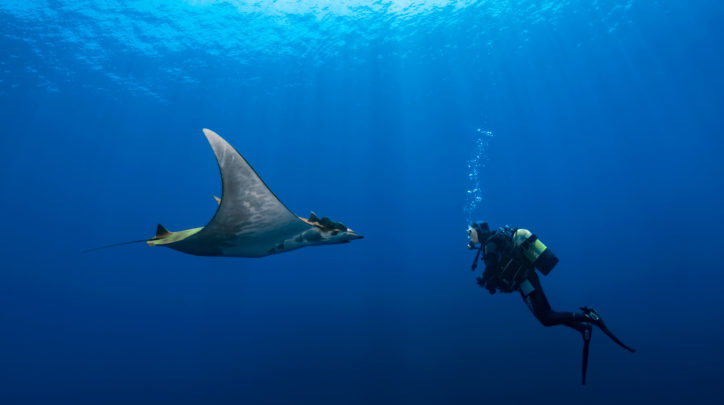
(Devil fish. Photo by © Wahrmut Sobainsky. kids.nationalgeographic.com)
The main danger is injuring the large blood vessels. If this happens, the main task is to prevent a serious blood loss and, first of all, to stop the bleeding. If the injury is minor – all the same actions should be taken: hot water, painkillers and antihistamines. After the pain subsides, you should examine the wound in case of spine pieces and remove them carefully. In difficult situations, it’s better to go to the health care facility immediately.
As adriaticnature dealt with Myliobatiformes, the fish of the order of electric rays, that is, the Torpediniformes order, are worth mentioning. 3 species of this order are found in the Adriatic. All three representatives are more common in the southern part of the sea and are quite rare. Electric rays are capable of producing an electrical discharge, the voltage of which can reach up to 220 volts, depending on the type. Rays use this discharge when defending themselves or attacking their potential prey.
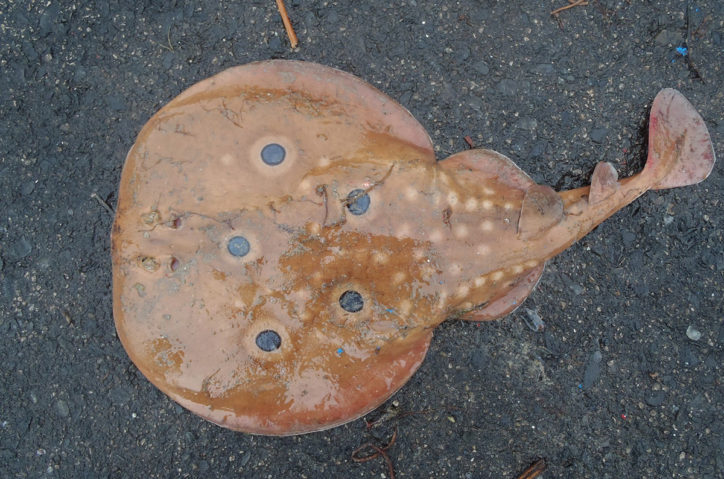
(Common torpedo. Photo by © theinvisibleworkshop.blogspot.com)
Both fishermen and divers can meet electric stingrays. The thing you surely shouldn’t do is to hold the back of the fish in one hand and its belly in the other, thus, closing the electrical circuit. However, electric shock doesn’t pose a serious danger to a human being, unless the diver gets disoriented in space and lose control of the dive, which can be life-threatening, and the fisherman recalls the safety of handling electrical appliances. There are no recorded fatal cases caused directly by the discharge.
Two representatives of the Acanthuroidei suborder, relatives of the bright coral “surgeon fishes”, like many other unexpected species, penetrated into the Mediterranean Sea and reached the Adriatic Sea through the Suez Canal.

(Marbled spinefoot. Photo by © Eleonora Cosentino. ultimatv.it)
The marbled spinefoot (Siganus rivulatus) and the dusky spinefoot (Siganus luridus) are new and strange fish of the sea, therefore, the encounter with foreigners may be less pleasant than with permanent inhabitants of the Adriatic, especially because the way they look doesn’t make people feel worried.

(Dusky spinefoot. Photo by © zsispeo. flickr.com/photos/zsispeo/)
The spines of the dorsal and anal fins of the spinefoot have venom glands. Stings are painful and cause the following symptoms, similar to the consequences of stings of weevers and scorpionfishes. First aid is the same: hot water and painkillers.
Another fish that has venom spines is one of the most common sharks of the Adriatic – the spiny dogfish, or the picked dogfish (Squalus acanthias). There are spines in front of the dorsal fins.
(Spiny dogfish. Video by © Alexandr Kurakin)
The sting of the spines is painful rather than dangerous to health. It may cause local pain, hyperemia and swelling. Such injuries are rare and more often occur because of careless handling of the fish caught.
Quite often, holidaymakers rather than anglers are worried about the following issue: are there any sharks that are dangerous to humans in the Adriatic Sea? The answer is – yes, there are. But the chances of meeting them are extremely low.
According to official sources, since 1899, about 60 cases of shark attacks on people or boats (including canoes) have been recorded. Although unofficial sources of information state that there were 6 attacks on people with fatal outcome only in Croatia over the past 140 years.
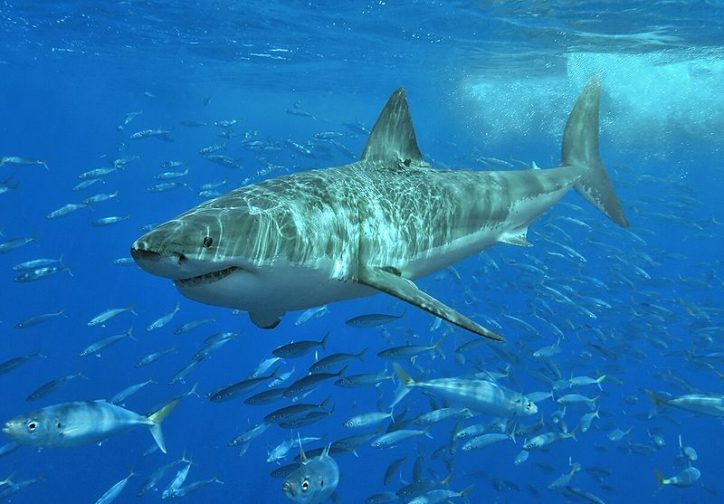
(Great white shark. Photo by © Terry Goss. a-z-animals.com)
All these troubles, mildly speaking, are supposed to have been caused by the great white shark (Carcharodon carcharias), although they are suspicious of the blue, or blue shark (Prionace glauca) as well.
Despite the fact that potentially dangerous sharks inhabit the Adriatic, it is very unlikely to meet them, according to the statistics.
Sharks rarely swim close to the shore, and if it happens, it happens more often in the winter.
That’s why, on the one hand, one should keep in mind the thoughts about these dangerous inhabitants of the sea, especially when bathing in places beyond public beaches, as well as in the deep sea; on the other hand, if you are constantly worried about something expecting trouble, you will rather find them at your hotel than in anticipation of meeting prehistoric beauties.
Recently, adriaticnature showed off and called the article about almost innocent fish – muraenas – “Dangerous beauties of the Adriatic Sea”. The article describes everything in detail, just be careful in dealing with moray eels, conger eels, and any marine predators that have teeth, and you’ll have no problems.
Perhaps, this point is where the danger on the first date with Adriatic fish ends. But trouble can occur on the second date.
Food poisoning caused by toxins contained in seafood is called marinotoxicosis.
Many people, who like to eat fish, have heard about the food poisoning because of eating tropical species of barracuda, muraena, triggerfish and other representatives of ichthyofauna. They apply this well-grounded information to the Adriatic. The main enemy of a human being, when eating cooked fish caught in tropical countries, is the poison called ciguatoxin, which causes the “fish” disease of ciguatera. Unicellular organisms, called dinoflagellates, or Dinophyta (coral fish feeds on it), contain it. And predatory fish feeds on coral fish of the same tropical waters.
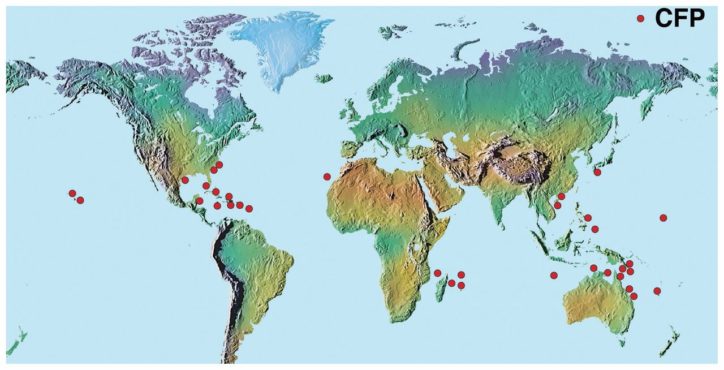
(Ciguatera risk zones on the world map. Figure © cmaj.ca)
Ciguatoxin is heat labile poison, so ordinary cooking can’t eliminate it from the products. No antidote has been found yet. In exceptional cases, death is possible. One should be aware of the ciguatoxin, but, if you are on the Adriatic shores, you can forget about it.
But here’s the thing that shouldn’t be forgotten. There’s poison that can get into the organism, when you eat fish from the Scombriae and Beloniformes suborders. Poisonings have been recorded after eating the garfish, mackerel and Atlantic bluefin tuna.
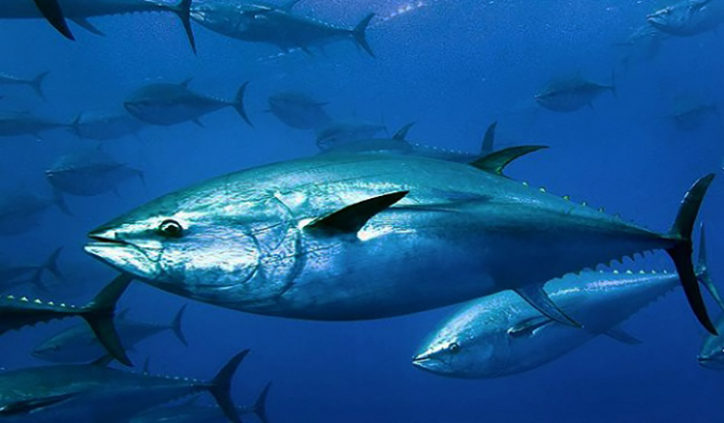
(Atlantic bluefin tuna. Photo © facts-about.info)
Scombrotoxin is the poison developed as a result of the growth and development of bacteria because of improper storage of fish. Repeated freezing, potential delicacies that haven’t been cooked for long periods of time provide an excellent reason for its occurrence in the tissues of fish. The toxin, like the ciguatoxin, is heat labile and doesn’t disintegrate at relatively high temperatures. As a rule, clinical signs occur immediately, sometimes while having meals, or later, but it is less often. Symptoms are as follows: a painful burning sensation in the mouth, rash and itching in the upper part of the body, decrease in arterial blood pressure, accompanied by nausea, vomiting, diarrhea, pain in the abdomen and a metallic aftertaste. The disease usually lasts about three hours. Taking antihistamine drugs has a positive effect.
Scombrotoxin is not a reason to avoid eating dishes from these fish species that are really useful for the human body. You should start cooking while the fish is fresh or has been defrosted only once.
One of the most poisonous toxins that can be accumulated in the fish tissue is tetradotoxin, or tetrodic acid. It became widely known for the stories about the Japanese fish dish “fugu”, the main ingredient of which is the fish called Japanese puffer (Takifugu rubripes). Fugu contains a lethal dose of tetrodotoxin in the internal organs, mainly in the liver and eggs, gall bladder and skin. Liver and eggs of fish shouldn’t be eaten at all, the rest of the body can be eaten after being carefully cooked. But the way it should be cooked is known only to Japanese chefs who have received a special license for cooking this dish. But sometimes they make mistakes.
The Japanese puffer doesn’t inhabit the Adriatic, but more recently, its relatives have penetrated into the Mediterranean Sea through the Suez Canal. They are not so popular in delicate cooking experiments, but not much less dangerous when eaten.
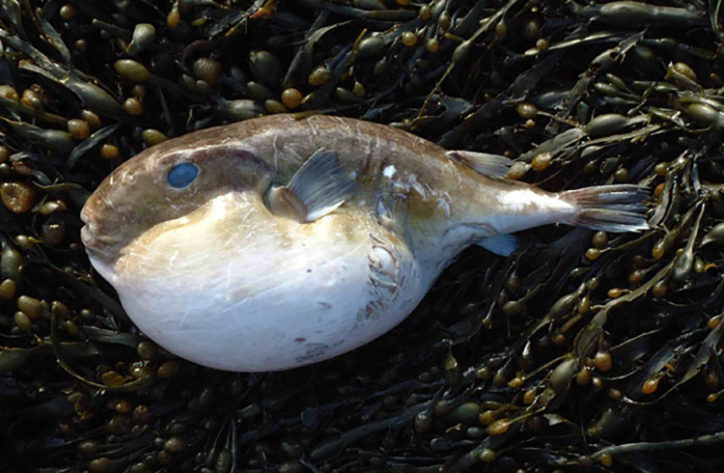
(Blunthead puffer. Photo by © Douglas Herdson/National Marine Aquarium. fishbase.org)
In the Adriatic Sea, the representatives of the Tetraodontidae family are still quite rare, however, the closer you get to the Ionian Sea, the more often you can find these completely uninvited guests.
In the Adriatic Sea, one can meet three members of the family. Perhaps, the way they look can’t be mistaken for any other inhabitants of the sea.
adriaticnature advises: if you catch the puffer, do whatever you want, just don’t taste it. And in this case, you’ll know what tetradotoxin is only from this article.
There are fishes that in no case should be eaten raw. If you think that Japanese rolls and sushi from eels are made using raw fish, you are mistaken. Eels (both river and sea ones, including moray eels) contain poison in their blood that is dangerous to human health and disintegrates during heat treatment.
You shouldn’t experiment with eating the shark liver. You are unlikely to do this on the Adriatic shores, but if someone offers you such a dish unexpectedly, pizza is the best alternative to that.
Let’s make it clear – adriaticnature is not a medical institution, all recommendations for first aid are taken from public sources!! In this article, adriaticnature aims at warning about the dangerous representatives of the ichthyofauna, and makes no claims as to anything more!
And, of course, be sure to remember the emergency phone numbers that you may need in difficult situations!
Albania: 112 – general emergency number; 127 – ambulance service;
Bosnia and Herzegovina: 112 – general emergency number; 124 – ambulance service;
Croatia: 112 – general emergency number; 194 – ambulance service;
Greece: 112 – general emergency number; 166 – ambulance service;
Italy: 112 – general emergency number; 118 – ambulance service;
Montenegro: 112 – general emergency number; 124 – ambulance service;
Republic of Macedonia: 112 – general emergency number; 194 – ambulance service;
Serbia: 112 – general emergency number; 194 – ambulance service;
Slovenia: 112 – general emergency number; 112 – ambulance service.